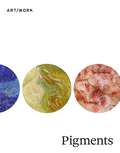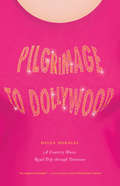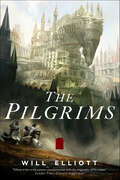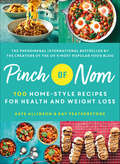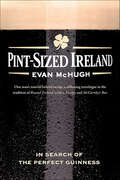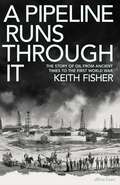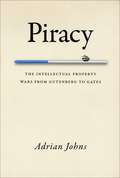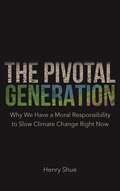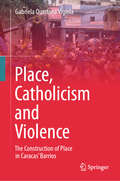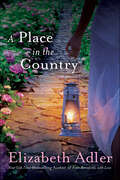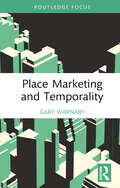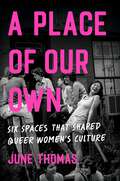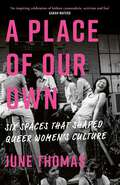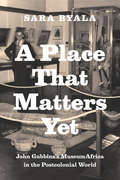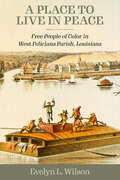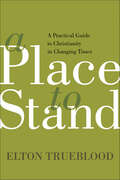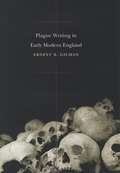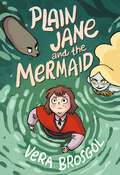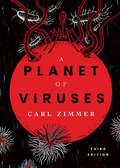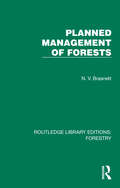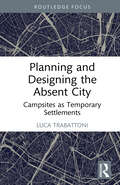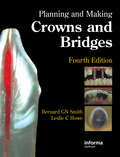- Table View
- List View
Pigments (ART/WORK)
by Ittai Weinryb Barbara H. Berrie Karin Leonhard Caroline FowlerA concise illustrated history of one of art&’s most important and elusive elementsOver the millennia, humans have used pigments to decorate, narrate, and instruct. Charred bone, ground earth, stones, bugs, and blood were the first pigments. New pigments were manufactured by simple processes such as corrosion and calcination until the Industrial Revolution introduced colors outside the spectrum of the natural world. Pigments brings together leading art historians and conservators to trace the history of the materials used to create color and their invention across diverse cultures and time periods. This richly illustrated book features incisive historical essays and case studies that shed light on the many forms of pigments—the organic and inorganic; the edible and the toxic; and those that are more precious than gold. It shows how pigments were as central to the earliest art forms and global trade networks as they are to commerce, ornamentation, and artistic expression today. The book reveals the innate instability and mutability of most pigments and discusses how few artworks or objects look as they did when they were first created.From cave paintings to contemporary art, Pigments demonstrates how a material understanding of color opens new perspectives on visual culture and the history of art.
Pilgrimage to Dollywood: A Country Music Road Trip through Tennessee (Culture Trails: Adventures In Travel Ser.)
by Helen MoralesA star par excellence, Dolly Parton is one of country music’s most likable personalities. Even a hard-rocking punk or orchestral aesthete can’t help cracking a smile or singing along with songs like “Jolene” and “9 to 5.” More than a mere singer or actress, Parton is a true cultural phenomenon, immediately recognizable and beloved for her talent, tinkling laugh, and steel magnolia spirit. She is also the only female star to have her own themed amusement park: Dollywood in Pigeon Forge, Tennessee. Every year thousands of fans flock to Dollywood to celebrate the icon, and Helen Morales is one of those fans. In Pilgrimage to Dollywood, Morales sets out to discover Parton’s Tennessee. Her travels begin at the top celebrity pilgrimage site of Elvis Presley’s Graceland, then take her to Loretta Lynn’s ranch in Hurricane Mills; the Country Music Hall of Fame and the Grand Ole Opry in Nashville; to Sevierville, Gatlinburg, and the Great Smoky Mountains National Park; and finally to Pigeon Forge, home of the “Dolly Homecoming Parade,” featuring the star herself as grand marshall. Morales’s adventure allows her to compare the imaginary Tennessee of Parton’s lyrics with the real Tennessee where the singer grew up, looking at essential connections between country music, the land, and a way of life. It’s also a personal pilgrimage for Morales. Accompanied by her partner, Tony, and their nine-year-old daughter, Athena (who respectively prefer Mozart and Miley Cyrus), Morales, a recent transplant from England, seeks to understand America and American values through the celebrity sites and attractions of Tennessee. This celebration of Dolly and Americana is for anyone with an old country soul who relies on music to help understand the world, and it is guaranteed to make a Dolly Parton fan of anyone who has not yet fallen for her music or charisma.
The Pilgrims: A Novel (The Pendulum Trilogy #1)
by Will ElliottThe Pilgrims is no ordinary alternate-world fantasy; with this first volume in The Pendulum Trilogy, Will Elliott's brilliantly subversive imagination twists the conventions of the alternate-world fantasy genre, providing an unforgettable visionary experience.Eric Albright is a twenty-six-year-old journalist living in London. That is to say he would be a journalist if he got off his backside. But this luckless slacker isn't all bad—he has a soft spot for his sometimes friend Stuart Casey, the homeless old drunk who mostly lives under the railway bridge near his flat. Eric is willing to let his life just drift by…until the day a small red door appears on the graffiti-covered wall of the bridge, and a gang of strange-looking people—Eric's pretty sure one of them is a giant—dash out of the door and rob the nearby newsagent. From that day on Eric and Case haunt the arch, waiting for the door to reappear.When it does, both Eric and Case choose to go through…to the land of Levaal. A place where a mountain-sized dragon with the powers of a god lies sleeping beneath a great white castle. In the castle the sinister Lord Vous rules with an iron fist, and the Project, designed to effect his transformation into an immortal spirit, nears completion. But Vous's growing madness is close to consuming him, together with his fear of an imaginary being named Shadow. And soon Eric may lend substance to that fear. An impossibly vast wall divides Levall, and no one has ever seen what lies beyond. Eric and Casey are called Pilgrims, and may have powers that no one in either world yet understands, and soon the wall may be broken. What will enter from the other side? The Pendulum Trilogy#1 The Pilgrims#2 Shadow#3 World's EndAt the Publisher's request, this title is being sold without Digital Rights Management Software (DRM) applied.
The Pimpernel Plot (Timewars #3)
by Simon HawkeSome might think the adventures of the Scarlet Pimpernel are just the stuff of adventure novels. But when time travel is perfected several hundred years in our future, it is discovered that the French Revolution critically depends on this daring Englishman, and then an accident results in him being killed before he even starts his grand carreer...
Pinch of Nom: 100 Home-Style Recipes for Health and Weight Loss (Pinch Of Nom Ser.)
by Kay Featherstone Kate AllinsonThe must-have cookbook from the UK's most popular food blog, Americanized for a US audience!For breakfast, lunch, dinner, and desserts, Kate Allinson and Kay Featherstone's pinchofnom.com has helped millions of people cook delicious food and lose weight. With over 100 incredible recipes, the Pinch of Nom cookbook can help beginner and experienced home-cooks alike enjoy exciting, flavorful, and satisfying meals. From Chicken Fajita Pie and Vegetable Tagine to Cheesecake Stuffed Strawberries and Tiramisu, this food is so good you’ll never guess the calorie count.Each recipe is labeled with icons to guide you toward the ones to eat tonight—whether you’re looking for a vegetarian dish, hoping to create a takeout meal, want to feed a family of four or more, or have limited time to shop, prep, and cook.Pinch of Nom is the go-to home cookbook for mouthwatering meals that work for readers on diet plans like Weight Watchers, counting carbs and calories, or following any other goal-oriented eating program.
Pint-Sized Ireland: In Search of the Perfect Guinness
by Evan McHughOne man's tour of Ireland on tap; a rollicking travelogue in the tradition of Round Ireland with a Fridge and McCarthy's Bar."Regret" is the word that best describes Evan McHugh's first taste of Guinness. For an Australian raised on Vegemite, Ireland's black brew is very much an acquired taste. But the travel-writer is committed to acquiring it. Determined to discover exactly what makes a pint of Guinness so legendary, he crosses the Emerald Isle in search of his answers.But in sampling pints as he goes, McHugh soon realizes that in each town, and at every pub, someone always says that the best glass of Guinness is to be found . . . . somewhere else. In his comedic and sentimental journey, McHugh and his companion, Twidkiwodm (the-woman-he-didn't-know-he-would-one-day-marry), hitch around Ireland, meeting unforgettable characters. He goes rowing with a German bagpiper on the lakes of Killarney, windsurfing with a one-armed man in Dingle, survives an encounter with poteen and even finds his own bar . . . but keeps searching for the perfect pint.As entertaining as it is informative, Pint-Sized Ireland is both a hilarious travelogue and thoughtful diary. McHugh's comedic voice swiftly moves in and out of pubs, peering into froth-rimmed pints, and leading readers to question: So does he ever find the perfect pot of black gold? Those who have rested upon the barstools of Ireland, who have sought the famed "perfect pint of Guinness," realize that perfection rests in more than just the taste. McHugh captures the visceral experience of Guinness and Ireland in a warm memoir that's perfect to savor.International Praise for Pint-Sized Ireland"McHugh's idea of traveling is one continuous pub crawl . . . an entertaining homage to the black brew."---The Age (Australia)"McHugh's writing style is intelligent, quirky, and conversational. The result is a consummately easy to read book, amusing and engaging. It'll make you want to go in search of your own perfect pint."---Adventure Travel"This is a lovely book, well written, full of humorous anecdotes and works both as a travelogue and as a guide to drinking in Ireland. One of the real joys of this book is the way that the author captures the nuances and syntax of the way the people speak (‘"Rooit", said the pub-landlord, ‘in ye coom"'). After a few pages you find yourself falling into this yourself and by the time you finish the book you will have developed a full-blown Irish accent."---www.bootsnall.com
A Pipeline Runs Through It: The Story of Oil from Ancient Times to the First World War
by Keith Fisher'Fascinating revelations' Max Hastings, Sunday Times'Wonderfully detailed and colourful' Steven Poole, Daily Telegraph'The book I have long been waiting for... Essential reading' Michael KlarePetroleum has always been used by humans: as an adhesive by Neanderthals, as a waterproofing agent in Noah's Ark and as a weapon during the Crusades. Its eventual extraction from the earth in vast quantities transformed light, heat and power. A Pipeline Runs Through It is a fresh, comprehensive in-depth look at the social, economic, political and geopolitical forces involved in our transition to the modern oil age. It tells an extraordinary origin story, from the pre-industrial history of petroleum through to large-scale production in the mid-nineteenth century and the development of a dominant, fully-fledged oil industry by the early twentieth century.This was always a story of imperialist violence, political disenfranchisement, economic exploitation and environmental destruction. The near total eradication of the Native Americans of New York, Pennsylvania and Ohio has barely been mentioned as a precondition for the emergence of the first industrialised oil region in the United States. Britain's invasion of Upper Burma in 1885 was perhaps the first war fought, at least in part, for access to oil; the growth of Royal Dutch-Shell involved the genocidal subjugation of people of the Dutch East Indies and the exploitation of oil in the Middle East arose seamlessly out of Britain's prior political and military interventions in the region.Finally, in an entirely new analysis, the book shows how the British navy's increasingly desperate dependence on vulnerable foreign sources of oil may have been a catalytic ingredient in the outbreak of the First World War. The rise of oil has shaped the modern world, and this is the book to understand it.
Pipers Farm The Sustainable Meat Cookbook: Recipes & Wisdom for Considered Carnivores
by Abby Allen Rachel Lovell'Without preaching, this argues for eating meat in a better way, sustainably, ethically, intelligently and with an understanding of farming' - Diana Henry, The Daily TelegraphThis book is a celebration of proper meat. Meat as it was before it got messed with. Before animals became a unit of production, but were reared to produce excellent food, and were willingly given an equally excellent life.It explores the connection between nature and farming and the result is a mixture of hands-in-the-earth wisdom and balanced seasonal recipes. Meat is revered and stretched as far as we can make it go by respecting the animal and using every part, cheek to lard, tendon to tail.The recipes are not just meat and two veg, but provide cooking that is devised for the way we live today. Think a modernised version of warming farmhouse food, to suit the weather and our homes. Fast, fresh, surprising dishes for midweek, and slow-cooking or theatre pieces shared with friends for weekends and holidays.Far from countering the vegan spike, this is the definition of fair, honest, sustainable food. This is meat done right.
Piracy: The Intellectual Property Wars from Gutenberg to Gates
by Adrian JohnsSince the rise of Napster and other file-sharing services in its wake, most of us have assumed that intellectual piracy is a product of the digital age and that it threatens creative expression as never before. The Motion Picture Association of America, for instance, claimed that in 2005 the film industry lost $2.3 billion in revenue to piracy online. But here Adrian Johns shows that piracy has a much longer and more vital history than we have realized—one that has been largely forgotten and is little understood.Piracy explores the intellectual property wars from the advent of print culture in the fifteenth century to the reign of the Internet in the twenty-first. Brimming with broader implications for today’s debates over open access, fair use, free culture, and the like, Johns’s book ultimately argues that piracy has always stood at the center of our attempts to reconcile creativity and commerce—and that piracy has been an engine of social, technological, and intellectual innovations as often as it has been their adversary. From Cervantes to Sonny Bono, from Maria Callas to Microsoft, from Grub Street to Google, no chapter in the story of piracy evades Johns’s graceful analysis in what will be the definitive history of the subject for years to come.
Pirana
by Rudie Van RensburgKASSIE SE VYANDE IS TOT DIE TANDE GEWAPEN … Wanneer Kassie Kasselman die saak van ’n vermiste oudkollega begin ondersoek, is dit duidelik hier skuil meer as net ’n dwelmverwante verdwyning. Hoe lyk dit dan vir Kassie of dit verband hou met twee ander sake − ’n ontvoering én ’n moord − op sy lessenaar? Van die Kaapse ganglands tot die Krugerwildtuin met sy renosterstropers; tussen ’n verslonsde Bolandse hoewe met ’n grieselige visdam en die glansen- skanswêreld van diplomasie moet Kassie sy pad voel-voel vind – of Rooi Els se vrou is visvoer.
The Pivotal Generation: Why We Have a Moral Responsibility to Slow Climate Change Right Now
by Henry ShueAn eminent philosopher explains why we owe it to future generations to take immediate action on global warmingClimate change is the supreme challenge of our time. Yet despite growing international recognition of the unfolding catastrophe, global carbon emissions continue to rise, hitting an all-time high in 2019. Unless humanity rapidly transitions to renewable energy, it may be too late to stop irreversible ecological damage. In The Pivotal Generation, renowned political philosopher Henry Shue makes an impassioned case for taking immediate, radical action to combat global warming.Shue grounds his argument in a rigorous philosophical analysis of climate change’s moral implications. Unlike previous generations, which didn’t fully understand the danger of burning carbon, we have the knowledge to comprehend and control rising carbon dioxide levels. And unlike future generations, we still have time to mitigate the worst effects of global warming. This generation has the power, and thus the responsibility, to save the planet. Shirking that responsibility only leaves the next generation with an even heavier burden—one they may find impossible to bear.Written in direct, accessible language, The Pivotal Generation approaches the latest scientific research with a singular moral clarity. It’s an urgently needed call to action for anyone concerned about the planet’s future.
Place, Catholicism and Violence: The Construction of Place in Caracas’ Barrios
by Gabriela Quintana VigiolaThis book explores the interwoven nature of place, Catholicism and violence in Caracas’ barrios. Using interdisciplinary perspectives to investigate themes of urban space, meaning as a psychosocial construct, criminal violence, and religiosity as culture, this book uncovers the underlying complexities of turning spaces into places through the built form, activities in the urban space and the meanings associated with it. Fundamental elements in the construction of place are used to understand the ways in which barrio residents conceive and construct the physicality of the private, public and religious spaces; how residents use the physical spaces of the barrios; and the psychosocial meanings residents associate with the spaces and activities. Using rich qualitative data and a case study design, the book relies on audio-visual data and interviews with organisers, residents and key participants in Petare, the largest barrio conglomeration in Caracas and Venezuela. Qualitative thematic analysis of participants’ experiences of Catholicism, violence and, ultimately, the construction of place exposes a unique argument: that meaningful urban spaces are embedded with emotions, memories, relationships, experiences and meanings, which turn them into places.
A Place in the Country: A Novel
by Elizabeth AdlerFifteen-year-old Issy and her newly single mother, Caroline Evans, are struggling to find their way alone, as well as together. At thirty-eight, with little money and all the responsibility for the two of them, Caroline is coming to terms with her new situation. When she decides to leave Singapore, home of her former well-off life (and her cheating husband), she ends up living in an English village pub, cooking dinners there to earn enough to get by, meeting unexpectedly quirky people, and making friends. But Issy still adores her father and secretly blames her mother for their change in life. Just as Caroline's dream of converting an old barn into a restaurant finally begins to take shape, her chance at happiness is threatened and hangs in the balance as whispers of murder and vengeance find their way to her. When Issy, who is hovering in that limbo between girl and young woman, begins to make some risky choices, the stakes are raised even higher. A Place in the Country is filled with emotions every woman will recognize as Caroline and Issy make their way in the world and do battle with those who would wish to see them lose their chances to gain their hearts' desires. Love and hate, blame and responsibility, deception and trust all collide in this novel that is Elizabeth Adler at her page-turning best. From The New York Times bestselling author comes an emotionally powerful novel about mothers and daughters, the secrets they share, and those they keep to themselves.
Place Marketing and Temporality (ISSN)
by Gary WarnabyMuch city marketing and branding activity is future-oriented; aimed at achieving a forward-looking vision for places. The aim of this activity is to attract visitors, residents and/or inward investment, and focus on communicating attractive place attributes to create a differentiated spatial ‘product’ that will appeal to particular target audiences. In seeking to achieve this, place marketing campaigns have been criticized for emphasizing generic attributes, such as accessibility, infrastructure and a skilled workforce—which can serve to homogenize places which in reality are very different. However, a city’s distinctive character is a consequence of its history and development over time, and this book analyses the role of these temporal dimensions in place marketing and branding. The book analyses how the past—both material (i.e. the historic built environment) and intangible (i.e. routines, practices and the ‘character’ of the populace)—is appropriated, in order to ‘sell’ the city into the future. It acknowledges the inherent selectivity involved and discusses the factors influencing what is remembered from the past—and equally importantly, what is forgotten. Adopting a range of theoretical approaches to understanding temporality in this context, the book will appeal to advanced students, academic researchers and reflexive place branding practitioners by introducing a ‘temporal paradox’ incorporating both fixity (the material and immaterial elements of the city’s past) and fluidity (relating to the creation of the place product as a dynamic assemblage of individual elements and attributes aimed at particular target audiences).
A Place of Our Own: Six Spaces That Shaped Queer Women's Culture
by June ThomasA &“riveting&” and &“indispensable&” (Alison Bechdel) cultural history of queer women&’s lives in the second half of the twentieth century, told through six iconic spaces For as long as queer women have existed, they&’ve created gathering grounds where they can be themselves. From the intimate darkness of the lesbian bar to the sweaty camaraderie of the softball field, these spaces aren&’t a luxury—they&’re a necessity for queer women defining their identities. In A Place of Our Own, journalist June Thomas invites readers into six iconic lesbian spaces over the course of the last sixty years, including the rural commune, the sex toy boutique, the vacation spot, and the feminist bookstore. Thomas blends her own experiences with archival research and rare interviews with pioneering figures like Elaine Romagnoli, Susie Bright, and Jacqueline Woodson. She richly illustrates the lives of the business owners, entrepreneurs, activists, and dreamers who shaped the long struggle for queer liberation. Thomas illuminates what is gained and lost in the shift from the exclusive, tight-knit women&’s spaces of the &’70s toward today&’s more inclusive yet more diffuse LGBTQ+ communities. At once a love letter, a time capsule, and a bridge between generations of queer women, A Place of Our Own brings the history—and timeless present—of the lesbian community to vivid life.
A Place of Our Own: Six Spaces That Shaped Queer Women's Culture - 'An inspiring celebration of lesbian camaraderie, activism and fun' (Sarah Waters)
by June ThomasLesbians are a people without a home. Perhaps that's why the ones we make for ourselves are so important.A highly readable cultural history of queer women's lives in the second half of the twentieth century, told through six iconic spaces'An inspiring celebration of lesbian camaraderie, activism and fun' SARAH WATERS'A cracking read, and a reminder of what shaped where we are now' VAL MCDERMID 'Riveting; indispensable; and suffused with a humane warmth' ALISON BECHDEL'A must-have for any queer bookshelf' TEGAN QUINFor as long as queer women have existed, they've created gathering grounds where they can be themselves. From the intimate darkness of the lesbian bar to the sweaty camaraderie of the softball field, these spaces aren't a luxury - they're a necessity for queer women defining their identities. Blending memoir, archival research and interviews, journalist June Thomas invites readers into six iconic lesbian spaces over the course of the last sixty years, including the rural commune, the sex toy boutique, the holiday destination and the feminist bookstore. She also illuminates what is gained and lost in the shift from the exclusive, tight-knit women's spaces of the '70s toward today's more inclusive yet more diffuse LGBTQ+ communities.'Pulses with delicious dykes and the spaces we have made for ourselves over the years. I welcome this story' STELLA DUFFY'A wonderfully rangy, conversational, and thoughtful exploration of lesbian geographies' DANIEL LAVERY'Immensely readable . . . A celebration of what was - and can be - built, with all the hurdles and ecstasies' ROSIE GARLAND
A Place That Matters Yet: John Gubbins's MuseumAfrica in the Postcolonial World
by Sara ByalaA Place That Matters Yet unearths the little-known story of Johannesburg’s MuseumAfrica, a South African history museum that embodies one of the most dynamic and fraught stories of colonialism and postcolonialism, its life spanning the eras before, during, and after apartheid. Sara Byala, in examining this story, sheds new light not only on racism and its institutionalization in South Africa but also on the problems facing any museum that is charged with navigating colonial history from a postcolonial perspective. Drawing on thirty years of personal letters and public writings by museum founder John Gubbins, Byala paints a picture of a uniquely progressive colonist, focusing on his philosophical notion of “three-dimensional thinking,” which aimed to transcend binaries and thus—quite explicitly—racism. Unfortunately, Gubbins died within weeks of the museum’s opening, and his hopes would go unrealized as the museum fell in line with emergent apartheid politics. Following the museum through this transformation and on to its 1994 reconfiguration as a post-apartheid institution, Byala showcases it as a rich—and problematic—archive of both material culture and the ideas that surround that culture, arguing for its continued importance in the establishment of a unified South Africa.
A Place to Live in Peace: Free People of Color in West Feliciana Parish, Louisiana
by Evelyn L. WilsonA Place to Live in Peace: Free People of Color in West Feliciana Parish, Louisiana reveals a community where free people of color lived harmoniously with white people even as slavery persisted. Author Evelyn L. Wilson documents the presence, land ownership, business development, and personal relationships of free people of color in this Louisiana parish. In the last decade before the Civil War, tensions over slavery in West Feliciana Parish, Louisiana, led to the separation of free people of color from their white counterparts. But until the 1850s, free people of color had lived and thrived there. The free people of color who inhabited West Feliciana Parish were not a settled population with a common background or a long history of freedom. Some entered the parish already free, others purchased their freedom, while others had been freed by slaveholders for differing reasons. Regardless of how they arrived in the parish, they found themselves in a community that valued the talents and skills they had to offer without regard to the color of their skin. These individuals were integrated into their community, lived among white neighbors, provided needed services, and owned successful businesses. Using extensive archival research, including court records, government documents, legal citations, and periodicals, Wilson interprets the lives, experiences, and contributions of free people of color in West Feliciana Parish. The integral role that these free people of color played in the parish complicates common understandings of the antebellum South.
A Place to Stand: A Practical Guide to Christianity in Changing Times
by Elton TruebloodA Place to Stand is addressed to those who recognize the need for a strong stand from which to operate in the confusion of contemporary thought. Ours has become an age, says Trueblood, in which people simply do not know what to think. Trueblood is convinced that there is an objective truth about everything. Here, Trueblood explains what Christians believe and why, exploring through each chapter rational Christianity, a center of certitude, the living God, the reality of prayer, and the life everlasting. He is convinced that part of the weakness of the Christian movement in this age has been the relative lack of emphasis upon belief. However good and important service to humanity is, it loses its motivating power when the sustaining beliefs are allowed to wither. A Place to Stand is a classic text that shows it is possible, without contradiction or confusion, to hold a Christian position which is both evangelical and rational.
Plague Writing in Early Modern England
by Ernest B. GilmanDuring the seventeenth century, England was beset by three epidemics of the bubonic plague, each outbreak claiming between a quarter and a third of the population of London and other urban centers. Surveying a wide range of responses to these epidemics—sermons, medical tracts, pious exhortations, satirical pamphlets, and political commentary—Plague Writing in Early Modern England brings to life the many and complex ways Londoners made sense of such unspeakable devastation.Ernest B. Gilman argues that the plague writing of the period attempted unsuccessfully to rationalize the catastrophic and that its failure to account for the plague as an instrument of divine justice fundamentally threatened the core of Christian belief. Gilman also trains his critical eye on the works of Jonson, Donne, Pepys, and Defoe, which, he posits, can be more fully understood when put into the context of this century-long project to “write out” the plague. Ultimately, Plague Writing in Early Modern England is more than a compendium of artifacts of a bygone era; it holds up a distant mirror to reflect our own condition in the age of AIDS, super viruses, multidrug resistant tuberculosis, and the hovering threat of a global flu pandemic.
Plain Jane and the Mermaid
by Vera BrosgolFrom Anya's Ghost and Be Prepared author Vera Brosgol comes an instant classic graphic novel that flips every fairy-tale you know on its head, and shows one girl's crusade for the only thing that matters—her own independence.Jane is incredibly plain. Everyone says so: her parents, the villagers, and her horrible cousin who kicks her out of her own house. Determined to get some semblance of independence, Jane prepares to propose to the princely Peter, who might just say yes to get away from his father. It’s a good plan! Or it would’ve been, if he wasn’t kidnapped by a mermaid. With her last shot at happiness lost in the deep blue sea, Jane must venture to the world underwater to rescue her maybe-fiancé. But the depths of the ocean hold beautiful mysteries and dangerous creatures. What good can a plain Jane do?
A Planet of Viruses: Third Edition
by Carl ZimmerIn 2020, an invisible germ—a virus—wholly upended our lives. We’re most familiar with the viruses that give us colds or Covid-19. But viruses also cause a vast range of other diseases, including one disorder that makes people sprout branch-like growths as if they were trees. Viruses have been a part of our lives for so long that we are actually part virus: the human genome contains more DNA from viruses than our own genes. Meanwhile, scientists are discovering viruses everywhere they look: in the soil, in the ocean, even in deep caves miles underground. Fully revised and updated, with new illustrations and a new chapter about coronaviruses and the spread of Covid-19, this third edition of Carl Zimmer’s A Planet of Viruses pulls back the veil on this hidden world. It presents the latest research on how viruses hold sway over our lives and our biosphere, how viruses helped give rise to the first life-forms, how viruses are producing new diseases, how we can harness viruses for our own ends, and how viruses will continue to control our fate as long as life endures.
Planned Management of Forests (Routledge Library Editions: Forestry)
by N. V. BrasnettOriginally published in 1953, this book was compiled to provide students of forestry with a simple outline of what the management of forests involves, and of the way in which forestry operations are organized and controlled. Topics discussed and explained include economic considerations, stock mapping, topography, climate, soils, form and distribution of crops, scientific forestry, destruction of forests, regulation by volume, area and size and forest protection.
Planning and Designing the Absent City: Campsites as Temporary Settlements
by Luca TrabattoniThis book concerns the study of open-air accommodation facilities. The market evolutions allow us to look at these structures as temporary settlements characterised by a low-density dwelling and a close connection with natural elements and the landscape.This new and different point of view is sustained by the tendency of outdoor tourism to go in the direction of temporary villages, and this tendency is directly related to "time" and "landscape". The landscape is the reason why the campsite is settled. The time is linked to the holiday season timing. Today, both are greatly influenced by the introduction of the "Maxi-Caravan". This removable living unit can be placed on the empty pitch, occupying the landscape without ruining the soil. By the settlement of Maxi-Caravans, the campsite is transformed from an empty landscape with tents to a temporary settlement, whose timing is divided between the seasonal timing of the campsite and the "timing" of the product, and whose landscape is organised by the relation with the prevalent landscape and the internal one. The book's core defines the outdoor facility structure, using Italy as the main case study. To identify design strategies, the book analyses temporary settlement examples (quick time) and projects from historic outdoor tourism (medium time). Finally, the last chapter reflects on open-air accommodation facilities by showing their applicability in the different contexts of the refugee camps (long time).The aim of this research is to enhance the theme of open-air accommodation facilities, highlighting the need to equalise the study of temporary settlements with that of permanent settlements. It will be of interest to researchers and students of planning, landscape and tourism.
Planning and Making Crowns and Bridges
by Leslie C. Howe Bernard G.N. SmithThis highly successful text, which has achieved wide acclaim among practitioners and is a recommended text in the major dental schools, has again been revised and updated to keep it at the forefront of clinical practice.
